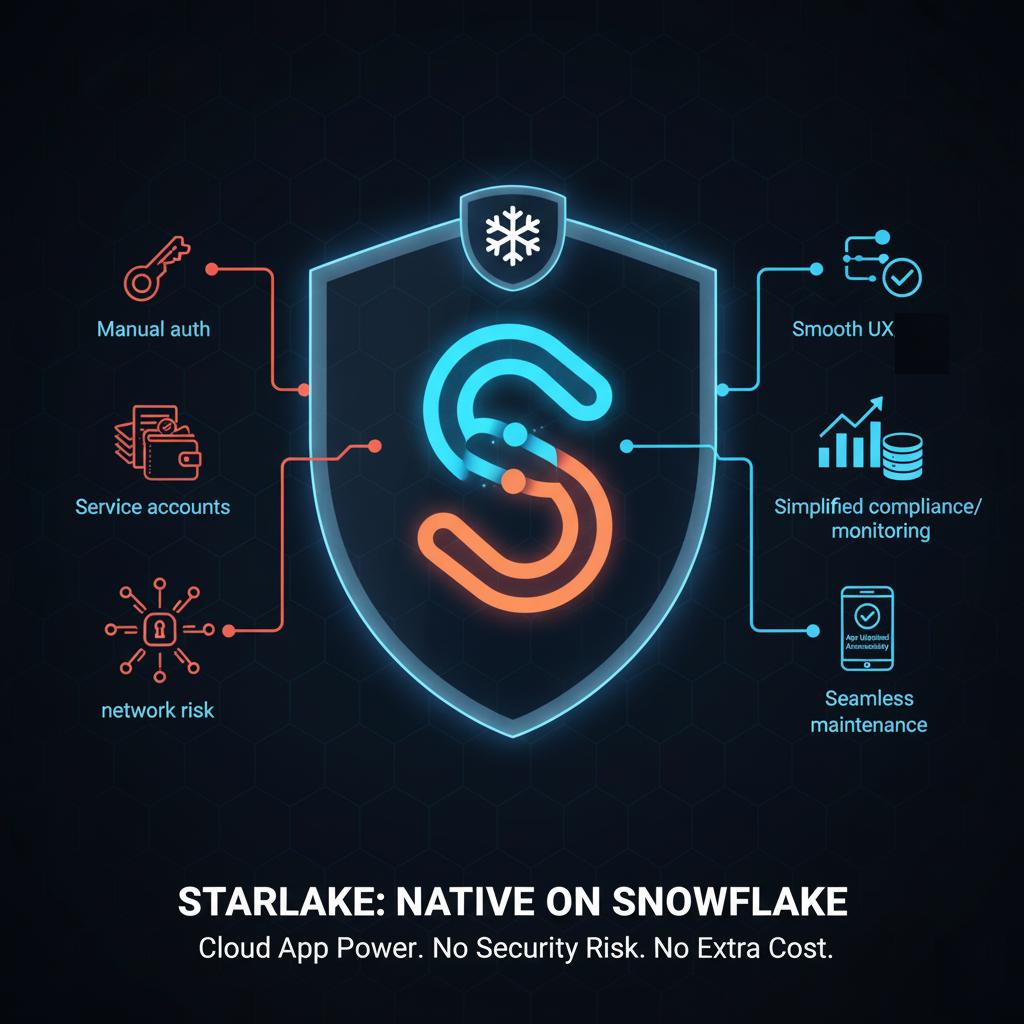Why Starlake Chose to Go Native with Snowflake

As a modern ETL/ELT framework, Starlake's core mission is to manage complex data pipelines securely and efficiently. To fully deliver on this promise and eliminate the operational burdens of external data processing, Starlake made the strategic decision to embrace the Snowflake Native App Framework.
Deploying Starlake directly within the consumer's Snowflake account, using the Native App model, unlocks a host of benefits that are simply unattainable with out-of-platform deployments, directly addressing the pain points of traditional data architecture, particularly around security, cost, and governance.
The Pillars of Native App Advantage
1. Security & Compliance
The Native App framework fundamentally shifts the security burden by leveraging Snowflake's existing perimeter, minimizing attack surfaces, and eliminating manual credential management.
-
Smooth User Experience (UX): Traditional external apps require manual setup involving API keys, service accounts, or external OAuth flows. Native Apps eliminate this friction.
They automatically inherit the existing session, meaning there is no need to connect to your account manually again and no need to create a consumer key/secret that could be compromised. All interactions are managed securely via Snowflake's trusted authentication flows.
-
Avoid Service Account Files: Say goodbye to security risks inherent in managing private keys. There is no need to manage service account files that could be leaked or lost, as the application runs under Snowflake's controlled identity system.
-
Network Security (Zero Egress Risk): When data leaves a secure network, it is vulnerable. With Native Apps, no egress/ingress rules are opened to the world. Your data and transformations stay inside Snowflake's secure network, mitigating the risk of data exfiltration.
-
Applicative Security (Restricted Call Rights): This is perhaps the most powerful security benefit. By using Snowflake's restricted call rights for applications, you can ensure that only authorized applications can access specific resources.
For instance, you can restrict an application to only access certain databases or schemas, irrespective of the user's broader permissions. This minimizes the risk of unauthorized data access.
Scenario: Imagine a developer who has access to your dev and production databases. If the user by mistake runs the ETL application against the production database, it could lead to data corruption or loss.
However, if the ETL application is configured with grant caller rights and restricted to only access the dev database, the application will not be able to interact with the production database, even if the developer has access to production. This adds an extra layer of protection against accidental misuse of privileges.
-
Simplified Compliance: All your data access and processing happens within Snowflake's compliance boundaries. This makes it easier to adhere to regulations like GDPR, HIPAA, etc., as you are not introducing a new external environment to audit.
2. Optimized Performance and Financial Control
By keeping the application logic and data processing close to the data itself, Native Apps deliver performance and cost advantages.
-
Optimized Performance: You leverage Snowflake's infrastructure to run AI/ML workloads close to your data, reducing latency and improving performance, as data movement is virtually eliminated.
-
Seamless Integration: Benefit from tight integration between Snowflake and AI/ML services, enabling smoother workflows and robust data pipelines without complex external orchestration.
-
Financial Control: Consumers gain immediate transparency. They can monitor and control the usage of services via Snowflake's resource monitors and usage tracking. This eliminates the risk of unexpected bills from 3rd party cloud providers.
-
Cost Efficiency: There is a potential for lower costs by consolidating workloads within Snowflake, avoiding additional setup, maintenance, and compute charges from external cloud services.
3. Operational Simplicity
Starlake chose the Native App route to drastically reduce the operational burden for users. Like applications downloaded from the Apple App Store or Google Play Store, Snowflake Native Apps are updated automatically without user intervention or knowledge.
Once you've installed Starlake, you are always running the latest version. This eliminates complex version control, manual patching, and coordination of updates across different environments, ensuring users benefit immediately from new features, performance optimizations, and critical security patches without lifting a finger.
Conclusion: The Best of Both Worlds
By choosing the Snowflake Native App framework, Starlake delivers the best of both worlds.
-
Users gain the operational simplicity and modern user experience of a true cloud application, including the seamless maintenance and automatic updates that eliminate version management headaches.
-
Crucially, they get this without the typical drawbacks of external tools: no complex network security configurations, no external service account management, and no surprise bills from third-party cloud providers.
Starlake running natively inside Snowflake means you get the power and convenience of a cloud app, coupled with the unprecedented security and financial control of the Snowflake Data Cloud.